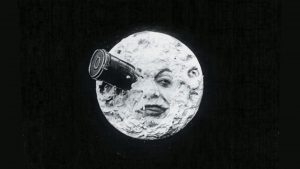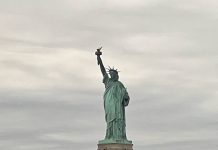In the midst of the space race of the 1950s, to prove technological and by extension, political supremacy, the United States and the Soviet Union engaged in what might now be considered an odd, if not downright stupid goal, of dropping a nuclear bomb on the moon. That’s right, both Uncle Sam and the Big Bear wanted to nuke Earth’s only natural satellite. Lunacy you say? Maybe, but also true.
The fervor began when the Soviet Union launched the satellite Sputnik (for which Russia has now named their COVID-19 vaccination, not incidentally). This was seen as both a challenge and a provocation in the United States. As history.com reports, “ As the two Cold War superpowers duked it out for postwar world dominance—framed by many as a titanic struggle between freedom and tyranny—the prospect of America’s arch enemy gaining any measure of military-industrial advantage seemed chilling indeed.”
The underlying fear, of course, was that Sputnik was a precursor to a robust buildup of advanced weapons, including nuclear capabilities. As the U.S. Department of State Archives states, “On October 4, 1957, the Soviet Union launched the earth’s first artificial satellite, Sputnik I. The successful launch came as a shock to experts and citizens in the United States, who had hoped that the United States would accomplish this scientific advancement first. The fact that the Soviets were successful fed fears that the U.S. military had generally fallen behind in developing new technology. As a result, the launch of Sputnik served to intensify the arms race and raise Cold War tensions.”
The overall perception was that the United States was not only falling behind the Soviet Union but putting its citizens and the entire free world in peril. As todayinhistory.com frames it, “The stakes could not have been higher, as each side sought to demonstrate the superiority of its own technology, military might and, by implication, the dominance of its political and economic system.”

Source: mentalfloss.com
In response, the United States created the Vanguard rocket program with the eventual aim of launching our own satellite into space, thus besting the Soviet Union. Unfortunately, the initial stages of the program were witness to multiple disasters. In fact, the first Vanguard rocket barely made off the ground.
As the New York Times archives reported on December 7, 1957: “The rocket bearing the United States test satellite burst into flame and was almost consumed on Cape Canaveral beach this morning two seconds after firing. It had risen two to four feet. The seventy-two-foot Vanguard vehicle — only forty-five inches in diameter at its widest point — was wrecked by a great fiery billow of flames nearly twice as high as the rocket itself. Surprisingly, the satellite-bearing third stage, embedded in the nose of the second stage, survived the crash of the rocket.”
This was an unmitigated PR disaster for the United States. As NASA points out, “The press called the failed attempt ‘Flopnik’ and ‘Kaputnik,’ in reference to its successful Soviet counterpart.” The second Vanguard launch met with an equal fate, exploding in flames only seconds after launch. And although the United States eventually succeeded with future iterations of Vanguard rockets, launching three satellites into orbit, a bizarre parallel scheme emerged: let’s drop a nuclear bomb on the moon and show the Soviet Union who’s really in charge.
Known officially as “Project A119,” AKA “A Study of Lunar Research Flights,” the idea was hatched out of the paranoia that accompanied the cold war. As Cold War historian Vince Houghton remarks, “We need to do something so big that the whole world will know that this was just an anomaly, that Sputnik was just a blip, that the United States was still the big kid on the block.”
And physicist Leonard Reiffel, who led Project A119, echoed these sentiments, saying, “People were worried very much by (first human in space Soviet cosmonaut Yuri) Gagarin and Sputnik and the very great accomplishments of the Soviet Union in those days, and in comparison, the United States was feared to be looking puny. So this was a concept to sort of reassuring people that the United States could maintain a mutually-assured deterrence, and therefore avoid any huge conflagration on the Earth.”
Yes, you got it right. The thinking was, nuke the moon, so we don’t nuke each other. I mean after all, what could go wrong?
To exacerbate the paranoia, “In 1957, newspapers reported a rumor that the Soviet Union planned a nuclear test explosion on the moon, timed to coincide with the lunar eclipse of November 7, and celebrating the anniversary of the Glorious October Revolution” according to todayinhistory.blog.
In an interview with The Guardian, former NASA executive Leonard Reiffel, who said he was asked to ‘fast track’ the program in 1958, stated, “It was clear the main aim of the proposed detonation was a PR exercise and a show of one-upmanship. The Air Force wanted a mushroom cloud so large it would be visible on earth. [This by the way would not happen. Watch the video below.] The US was lagging behind in the space race,” adding, “The U.S. Air Force were mainly concerned about how the nuclear explosion would play on Earth.”
Well, when you put it that way, it’s totally understandable, no? After all, what’s a little lunar nuclear explosion between friends, or enimies?
Eventually, cooler heads prevailed, and our government abandoned the project, as apparently did the USSR. While claims of displacing the orbit of the moon are wild and unsupported by science, there may have been some negative repercussions. To begin with, the debris created by the nuclear blast would have wreaked havoc for anything in orbit. As Popular Mechanics points out, “The explosion would also likely create a shotgun-like blast of moon debris, as lower gravity makes it easier for moon rocks and dust to easily escape the moon’s gravity. This would be ejected into space, but also strike Earth, creating micrometeor showers visible in the night sky. Those same micrometeors would also be a hazard for satellites and space stations.”
Secondly, the moon, as barren as it may be, is likely home to future members of the human race. It is mostly untouched by human hands, and because of that, its purity has been preserved. As Reiffel himself said, “I made it clear at the time there would be a huge cost to science of destroying a pristine lunar environment, but the US Air Force were mainly concerned about how the nuclear explosion would play on earth.”
But the bigger consequence may have been that we would have ratcheted up the cold war zeal, thus escalating the tensions between us and our Soviet counterparts, each ready to attack upon the slightest provocation. As J. Robert Oppenheimer, the world-famous inventor of the Atomic bomb that was dropped on Hiroshima and Nagasaki warned us, the United States and the Soviet Union were like “two scorpions in a bottle, capable of killing the other but only at the risk of its own life.”
Yet, at the end of the day, nuking the moon is poses no real threat when you ponder the absurdity of the world’s nuclear arsenal and its potential to utterly destroy ourselves here on Earth. Alex Wellerstein, a nuclear historian at the Stevens Institute of Technology, leaves us with this warning: “Even setting off a nuclear weapon on the moon is not as bad of an idea as having 10,000 nuclear weapons, many of them multi-megaton in range, and having them on a sort of 24-hour hair-trigger alert. In a way, the stuff they did do was a lot crazier, but we’ve sort of normalized it.”
If you would like to watch a video of what would potentially happen if we dropped a nuclear bomb on the moon, check this out.
At Newsweed.com, we adhere to three simple principles: truth, balance, and relatability. Our articles, podcasts, and videos strive to present content in an accurate, fair, yet compelling and timely manner. We avoid pushing personal or ideological agendas because our only agenda is creating quality content for our audience, whom we are here to serve. That is why our motto is ”Rolling with the times, straining for the truth.”
Your opinion matters. Please share your thoughts in our survey so that Newsweed can better serve you.
Charles Bukowski, the Los Angeles beat poet that captured the depravity of American urban life once said, “There is something about writing poetry that brings a man close to the cliff’s edge.” Newsweed is proud to stand in solidarity and offer you a chance to get close to the cliff’s edge with our first Power of Poetry Contest. Are you a budding bard, a versatile versifier, a rhyming regaler? Do you march to the beat of iambic pentameter, or flow like a river with free verse? If so, here’s your opportunity to put your mad poetic chops to the test. Enter our poetry contest for bragging rights and an opportunity to win some cash!






